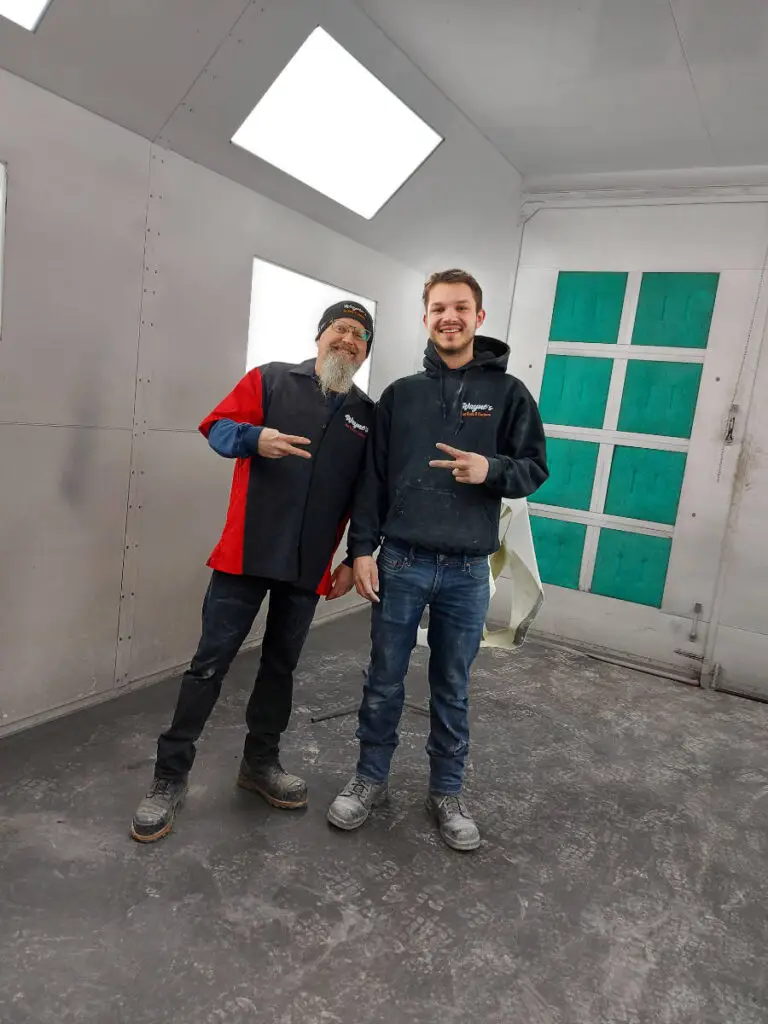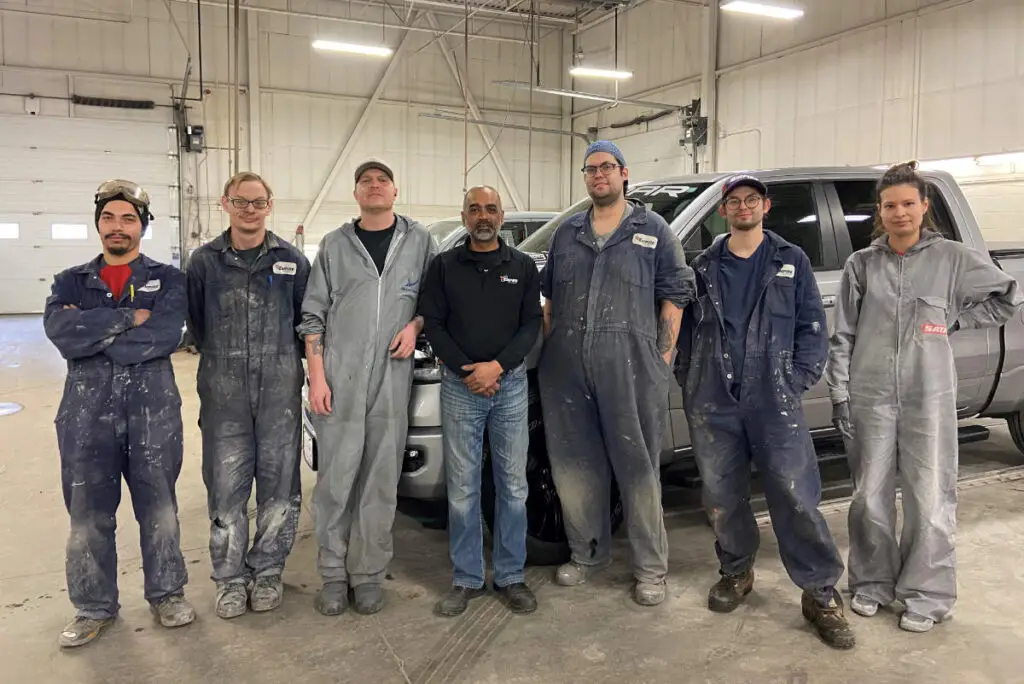Empire Collision technician crew
Clue: they may already be in your shop.
by Eli Greenbaum
Two perennial questions arise among collision centre owners and managers throughout Canada: 1) how to find competent body and paint technicians? And 2) how to ensure that they have the right qualifications and attitude to be positive assets for your shop?

Collision Quarterly, Spring 2022
It seems that shops of any size can always benefit from another paint or body tech. As experienced techs retire or move on, they need to be replaced. As collision centres succeed and expand, they need more help. The issue is an ongoing one.
Consequently, wise managers are always on the lookout for skilled techs. Fortunately, there are several ways to find them. One way is to attract experienced techs you are familiar with from other collision centres. Offer them better wages, better working conditions, or other benefits, and chances are you may lure them to your establishment. But will they mesh with your shop’s culture? And how long will they stay before some other centre lures them from you? Plus, what does that do to the morale in your shop if other techs see the new person come in as a favourite?
You could always advertise that you have an opening, or put the word out through the collision centre grapevine. But that could take some time, and while such efforts may turn up a qualified tech or two, you will have to check references and perform due diligence to make sure those individuals are genuinely qualified and able to do the work required. And if you do hire such an individual, there is always the possibility that you would run into the same personnel and morale problems noted above.
There is another path to take. It is one that requires patience, commitment, and a true investment on a collision centre’s part: develop your own talent from within. It is not easy, but the return on investment can be significant and worthwhile.
Attract the talent
There are young people out there who are interested in the collision industry as a career. You can help identify the best ones, educate them, and, hopefully, employ them.
Start by cultivating your recruitment opportunities. One obvious way is to get involved with local schools that offer automotive collision training. These could be community colleges, vocational schools, even high schools in your area. There, you will meet students who are taking classes in automotive collision repair and already attracted to the field. By showing an interest in them, you can establish a presence in their school’s program and make yourself visible and known. Get to know the people who run the programs—administrators and instructors alike—and ask how you can get involved. Visit classes, donate supplies, and invite students or entire classes to your shop. Show that you are receptive to sharing your knowledge of the industry. Soon you will start to recognize which students are serious and want to learn more. These are the ones to keep an eye on.
These same schools frequently hold job fairs and training events in which you can participate. You can also put on similar events or skills classes at your shop to help distinguish your centre. Think of this step as a sound marketing tactic that can make your shop desirable to your audience of potential employees. If you want an edge in attracting those prospective technicians when it is time for them to find a job or apprenticeship program, make sure you are top of mind.
". . . develop your own talent from within. It is not easy,
but the return on investment can be significant and worthwhile.”
Another way to find new talent is to talk to friends, relatives, and your current employees to find out if they know any young people interested in a hands-on trade that offers a rewarding career. You might be surprised that someone in your circle knows someone who has a genuine interest in collision repair or refinish. Of course, just knowing someone does not mean they are suitable as a technician, but it is one more person to consider, and it could turn out to be the right person.
Hire them, and give them a chance
Vocational programs are a great source for finding entry-level technicians. But even with their classroom and shop training, students are inexperienced when they come into a collision centre to work. Does the lack of practical experience compromise a young person’s chance for success and lessen their value to you? Not for Michael O’Callaghan, chief operating officer and vice president of operations for the Craftsman Group. The company owns 40 collision centres across Saskatchewan, Alberta, and British Columbia. O’Callaghan is a 36-year veteran of the collision repair industry, the last 26 at the Craftsman Group. He hires about 25 people every year for the company’s apprenticeship program.
“I’m 100 percent willing to hire inexperienced young people,” O’Callaghan said. “In fact, I prefer inexperienced, tech-focused individuals who are enthusiastic about joining the collision repair industry. We will train them to be solid professionals.”
When young people enter the Craftsman Group’s four-year training program, O’Callaghan gives them a $4,000 toolbox and assigns them to a mentor—a senior tech. The two work side by side in a structured program as the rookie gains experience by doing actual repair work. As O’Callaghan said, “When the kids come in, we don’t give them a broom, we put tools in their hands and teach them the ropes.”
O’Callaghan acknowledges that shop leaders often want experienced help; however, he is willing to make the investment in new talent. “I want kids that can get along—kids with a positive attitude and great work ethic. I can teach a young person to fix a dent. I can’t teach them good attitude.”
To attract talent, O’Callaghan’s team actively participates in building relationships and being a visible part of the community. He chairs the Vancouver Community College industry advisory committee and other Craftsman Group senior leaders work with the British Columbia Institute of Technology. At both schools O’Callaghan speaks to collision repair classes about the field, industry developments, and their career opportunities. He has succeeded in making the Craftsman Group an appealing option for students while he simultaneously scouts potential apprentices. O’Callaghan and the Craftsman Group are so committed to the hunt for new talent that they will often pay a student’s school tuition and room and board.
The Craftsman Group program currently has 60 apprentices training at various stages of skill and experience. This is obviously a significant investment in untested personnel. Regardless, O’Callaghan sees it as a valuable approach.
“These investments are extremely worthwhile,” he said. “Our program pays dividends by providing training, generating a high loyalty rate, and ensuring that we have a highly skilled team of body and paint technicians in-house.”
At Empire Collision, a production shop operation with three locations in Edmonton, manager Richard Chand shares O’Callaghan’s outlook and has a proprietary system in place to welcome new talent and develop them to become exceptional technicians. And no, they do not start out sweeping the floors here either.
Chand has a firm relationship with instructors at North Alberta Institute of Technology. This allows him to identify and observe exceptional students in the school’s collision repair program. He hires three students a year from the program and brings them into his shop—Empire Collision South, the busiest of the company’s centres. Once there, the students are part of a technician team that addresses the many steps in the Empire repair process. These include vehicle prepping, disassembly, parts ordering, body and paint work, reassembling, and final quality review. Each of these processes has numerous sub-steps. Chand monitors team and individual progress on a daily basis, continuously reviewing individual performance, data, and service procedures to ensure quality control.
As a former painter and bodyman, Chand understands what goes into being a professional technician and the value such an individual brings to a collision centre. “We want a happy environment and a team effort,” he said. “We understand the importance of developing our own talent and the skill and loyalty that can generate. We will hire them, put them through school, and train them properly. We ask them where they see themselves in ten years, and most of them say ‘Right here.’ We like that.”

Wayne's Hot Rods Customs
Smaller operations can do it too
In-house talent development is not reserved exclusively for multiple-location operations. Smaller centres and niche shops also develop technicians on the premises. Wayne Bishop, owner of Wayne’s Hot Rods & Customs in Waverley, Nova Scotia, and recently featured in a Collision Quarterly article about shops specializing in work involving customs and restorations, relies on developing his own talent. He has an instructor friend at Nova Scotia Community College (NSCC). “I’m receptive to new kids,” Bishop said. “I told my friend, ‘If you get a good kid, let me know.’”
Bishop’s friend did just that. Last year, he referred a young man, Gabe Godfrey, to Bishop. It turned out that Godfrey was someone Bishop already knew; he had coached him on the local high school’s basketball team. Godfrey was also the football team’s quarterback. Bishop knew that Godfrey was a good, hard-working kid. What he did not know was that Godfrey was interested in collision repair, but here he was looking for an opportunity, and Bishop believed he had potential. Because of the COVID situation, NSCC had waived a work placement requirement as part of its collision repair course requirements, but Godfrey—showing his eagerness to learn—wanted the placement nonetheless, and Bishop took him on.
Bishop does not have a formal apprenticeship program, but he is making sure Godfrey gets a well-rounded shop experience.
“In the first week, I threw him in the deep end of the pool,” said Bishop. “I got him sanding and working on the cars. There were no menial tasks, and I saw he was contributing and making money for the shop. Now he is learning and doing everything—bodywork, painting, fabricating, etc. He is working 40 hours a week and being paid the apprentice rate.”
Godfrey is in his second year at the shop, and Bishop is mentoring him. “Gabe is one of a kind, a sponge. He just wants to learn,” said Bishop. There are five other techs working at Wayne’s Hot Rods & Customs, a few of them close to retirement. Bishop sees Godfrey as a long-term investment, someone who could eventually be supervisory material. He is intent on keeping Godfrey on staff by following a simple formula of encouragement and support, letting him try new things, and rewarding him for his work.
“I’m open to taking a chance on new kids,” said Bishop, who then echoes the oft heard, “but their enthusiasm is critical. I can teach bodywork, I can’t teach attitude.” He went on to say, “Godfrey’s got the right attitude. And just because someone is experienced doesn’t mean they’re good. I’ve fired four guys in the last five years because they couldn’t do what they said they could.”
The industry is ready to help
You are not alone in your efforts to develop talent in house. Major players in the collision refinish industry are ready to help. Several paint companies have implemented programs specifically designed to help individuals with little or no shop experience learn the skills they need to succeed and contribute to your centre. These include such enlightened companies as BASF Automotive Refinish, Axalta Coating Systems, and PPG.
According to Ralph Leija III, BASF North America training manager, the company is well prepared to assist its Canadian customers with the development of new technicians. “We have an excellent team of technical service specialists who work with new technicians at their respective shops to become familiar with BASF products and processes. We also offer an advanced preparation techniques class that concentrates on the foundational skills required to perform various refinish operations. This class doesn’t focus on products. Instead, it provides instruction on general shop safety, personal safety, and equips new technicians with the skills they need to properly perform a variety of surface preparation operations.”
Axalta also recognizes the need for developing new talent and has established a training curriculum that focuses exclusively on skill development and enhancement. It offers apprentices the opportunity to excel at their trade. There are several courses in the program that take an apprentice to various levels of competency. One such course, “Prepper to Painter,” for example, specifically trains surface preppers to become qualified painters. The rigorous five-day course is intense. Additional courses concentrate on related refinish skills and work with new technicians to further develop their proficiency.
"When the kids come in, we don’t give
them a broom,
we put tools in their hands
and teach them the ropes.”
“Our intent is to focus on the development of techs from within,” says Patrice Marcil, North America customer experience director, Axalta Coating Systems. “Poaching is not healthy for our industry. We say to our customers that the talented young technicians you have are precious; you want to keep them. Our courses are designed to help you take them to the next level, to build competency and loyalty.”
PPG offers a refinish preparation specialist course at its business development centre in Toronto that is a core part of PPG’s training approach. The course trains entry-level automotive technicians in personal safety, equipment, and fundamental preparation procedures of the repair and refinish process. John Beauregard, PPG Refinish Solutions Specialist, Automotive Refinish, Canada, reports that feedback from employers and attendees has been positive.
“It’s my understanding that the benefits are immediate,” he said. “Techs leave the class having gained hands-on experience on process and product knowledge. This knowledge can be applied immediately upon returning to the shop floor. From there, practice and patience allow technicians to perfect their skills.”
More information about Axalta, BASF, and PPG technician development classes is available through the companies and their distributors.
There is no perfect solution for ensuring that you will always have a sufficient number of technicians available. But there are steps you can take to maximize your opportunities for access to those qualified to work with you and to bring them along to become valuable resources for your operations. Developing and relying on talent from within can work for those shops willing to make the investment, take a calculated risk, and reap the potential dividends: a loyal and well-trained work force that is comfortable and productive in your shop’s culture.





